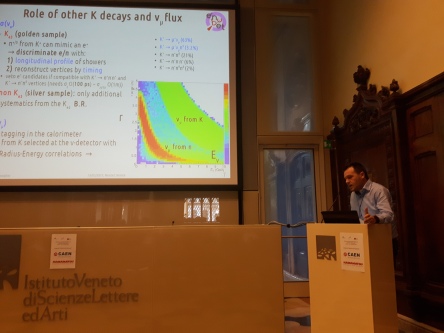The Enubet Project
 Andrea Longhin (left) described the Enubet project. This addresses the flux uncertainty problem in neutrino beams. The reason for the lack of an absolute measurement with <10% error is the presence of large systematics. A set of hadro-production experiments have been deployed for this. But in particular the electron neutrino flux remains poorly constrained.
Andrea Longhin (left) described the Enubet project. This addresses the flux uncertainty problem in neutrino beams. The reason for the lack of an absolute measurement with <10% error is the presence of large systematics. A set of hadro-production experiments have been deployed for this. But in particular the electron neutrino flux remains poorly constrained.
The electron neutrino cross section can spoil the discovery potential of future muon-neutrino to electron-neutrino oscillation experiments. Also knowing the dependence of cross section on energy is important to give a deeper insight in the underlying physics.
The ideal solution would be to study the decay in flight of stored muons, as in nuStorm, but it is not an easy solution. The idea of monitored beams is an alternative. We take an observable that is directly linked to the neutrino production. We fully instrument the decay region, so that the rate of kaon decays to positrons at large angle give an electron neutrino flux prediction by positron counting.
There is a hadron beam-line, with charge selection, focusing and transfer of pions or kaons to an instrumented decay tunnel. What is crucial is to do a good focusing of the hadron beam line, to prevent decays that have stray particles impinging on the target. One thus needs tolerable rates and irradiation. One also needs a full and continuous control of the bulk of the produced electron neutrinos from Ke3.
The baseline design is with 8.5 GeV hadrons, with 20% spread, and ❤ mrad spread in angle ofver a 10×10 cm^2 area. The tagger has a length of 50 meters, and a radius of 40 cm.
All the decay products of kaons give larger angle positrons that can be tagged. Additional samples can provide additional systematics reduction.
The challenge of the tagger is the rate: injecting 10^10 pions in a 2ms spill provides a harsh environment with rates above 200 kHz per cm^2.
For the hadron beam line one would use magnetic horns. To get sparser fills in the spills one needs many spills. Requiring 10^4 electron neutrino charged-current interactions ina 500 ton detector at 100 meters implies 0.5 to 5×10^20 protons on target, but also 2×10^8 spills.
Otherwise if one does not use horns, a static focusing can be used, large aperture rad-hard quadrupoles. This loses acceptance with respect to the horn choice. One needs more protons on target.
In a time-tagged neutrino beam one could do a time coincidence between the neutrino interaction and the tagging electron. If one could spread the arrival time of protons in the target this could be done. This can also be studied.
The goal of Enubet is to demonstrate the technique, to prepare a full-scale experimentt. The first step is the construction and test of a tagger demonstrator (3 meters of the instrumented decay tunnel). Then a study of systematics, followed by a design of the hadronic beamline; then the test of new proton extraction schemes at CERN. The tagger is envisioned to be a shashlik calorimeter with integrated light readout.